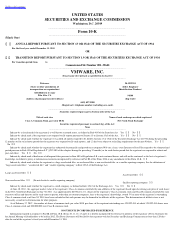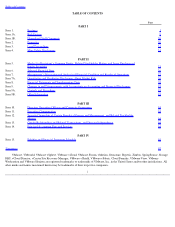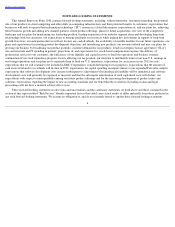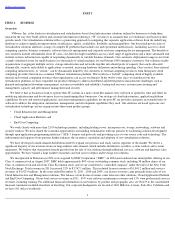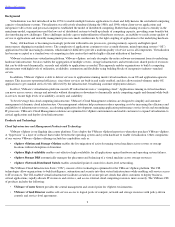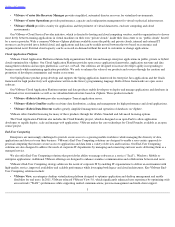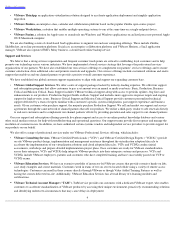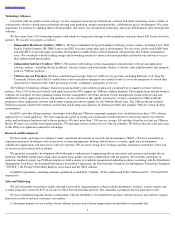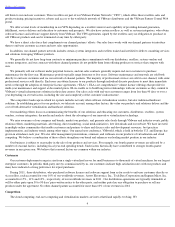VMware 2011 Annual Report Download - page 6
Download and view the complete annual report
Please find page 6 of the 2011 VMware annual report below. You can navigate through the pages in the report by either clicking on the pages listed below, or by using the keyword search tool below to find specific information within the annual report.
Table of Contents
PART I
Overview
VMware, Inc. is the leader in virtualization and virtualization-based cloud infrastructure solutions utilized by businesses to help them
transform the way they build, deliver and consume information technology ("IT") resources in a manner that is evolutionary and based on their
specific needs. Our virtualization solutions reflect a pioneering approach to computing that separates application software from the underlying
hardware to achieve significant improvements in efficiency, agility, availability, flexibility and manageability. Our broad and proven suite of
virtualization solutions addresses a range of complex IT problems that include cost and operational inefficiencies, facilitating access to cloud
computing capacity, business continuity, software lifecycle management and corporate end-user computing device management. The benefits to
our customers include substantially lower IT costs, cost-effective high availability across a wide range of applications and a more automated and
resilient systems infrastructure capable of responding dynamically to variable business demands. Our customers' deployments range in size from
a single virtualized server for small businesses to thousands of virtual machines for our Fortune 1000 enterprise customers. Our solutions enable
organizations to aggregate multiple servers, storage infrastructure and networks together into shared pools of capacity that can be allocated
dynamically, securely and reliably to applications as needed, increasing hardware utilization and reducing spending. Once created, these internal
computing infrastructures, or “clouds,” can be dynamically linked by our customers to external computing resources from third-party cloud
computing providers that run on a common VMware virtualization platform. This results in a “hybrid” computing cloud of highly available
internal and external computing resources that organizations can access on demand. In the twelve years since we introduced our first
virtualization platform, we have expanded our product offerings to address distributed and heterogeneous infrastructure challenges such as
planned and unplanned downtime management, system recoverability and reliability, backup and recovery, resource provisioning and
management, capacity and performance management and security.
We believe that as businesses look to operate their IT systems in a more cloud-like manner, they will seek to spend less time and effort on
underlying infrastructure and devote more focus on transforming their businesses. Our strategy of cloud infrastructure, application platform
capabilities for new and renewed applications, and client management capabilities for the post-PC era provides customers an extended suite of
software to address the integration, automation, management, and development capabilities they need. Our solutions are based upon our core
virtualization technology and are organized into three main product groups:
We work closely with more than 2,100 technology partners, including leading server, microprocessor, storage, networking, software and
security vendors. We have shared the economic opportunities surrounding virtualization with our partners by facilitating solution development
through open application programming interface (“APIs”) formats and protocols and providing access to our source code and technology. The
endorsement and support of our partners further enhances the awareness, reputation and adoption of our virtualization solutions.
We have developed a multi-channel distribution model to expand our presence and reach various segments of the market. We derive a
significant majority of our revenues from our large indirect sales channel, which includes distributors, resellers, system vendors and systems
integrators. We believe that our partners benefit greatly from the sale of our solutions through additional services, software and hardware sales
opportunities. We have trained a large number of partners and end users to deploy and leverage our solutions.
We incorporated in Delaware in 1998, were acquired by EMC Corporation (“EMC”)
in 2004 and conducted our initial public offering of our
Class A common stock in August 2007. EMC holds approximately 80% of our outstanding common stock, including 38 million shares of our
Class A common stock and all of our Class B common stock, and we are considered a “controlled company” under the rules of the New York
Stock Exchange. Total revenues in 2011 increased 32% to $3,767.1 million . This included license revenues of $1,841.2 million and services
revenues of $1,925.9 million . In the years ended December 31, 2011 , 2010 and 2009 , our license revenues came primarily from sales of our
Cloud Infrastructure and Management solutions. The balance of our license revenues came from our other solutions, Cloud Application Platform
and End-User Computing. Of our total services revenues in 2011 , 85% were software maintenance revenues and 15%
were professional services
revenues, including training. For additional financial information on our business by product and geographic area, see Note P to the consolidated
financial statements included elsewhere in this filing. Our corporate headquarters are located at 3401 Hillview Avenue, Palo Alto, California and
we have 101 offices worldwide.
1
ITEM 1.
BUSINESS
•
Cloud Infrastructure and Management;
•
Cloud Application Platform; and
• End-
User Computing.


